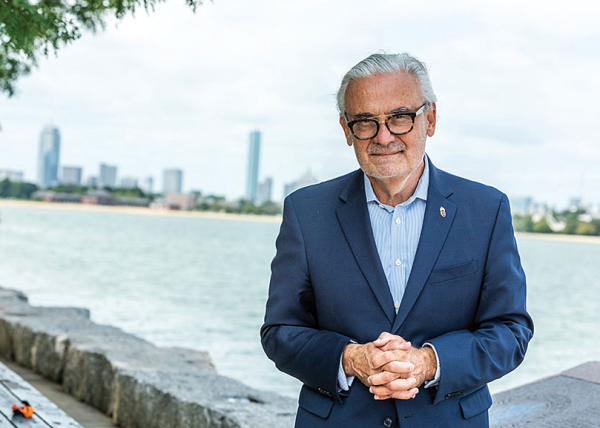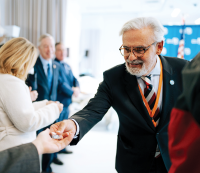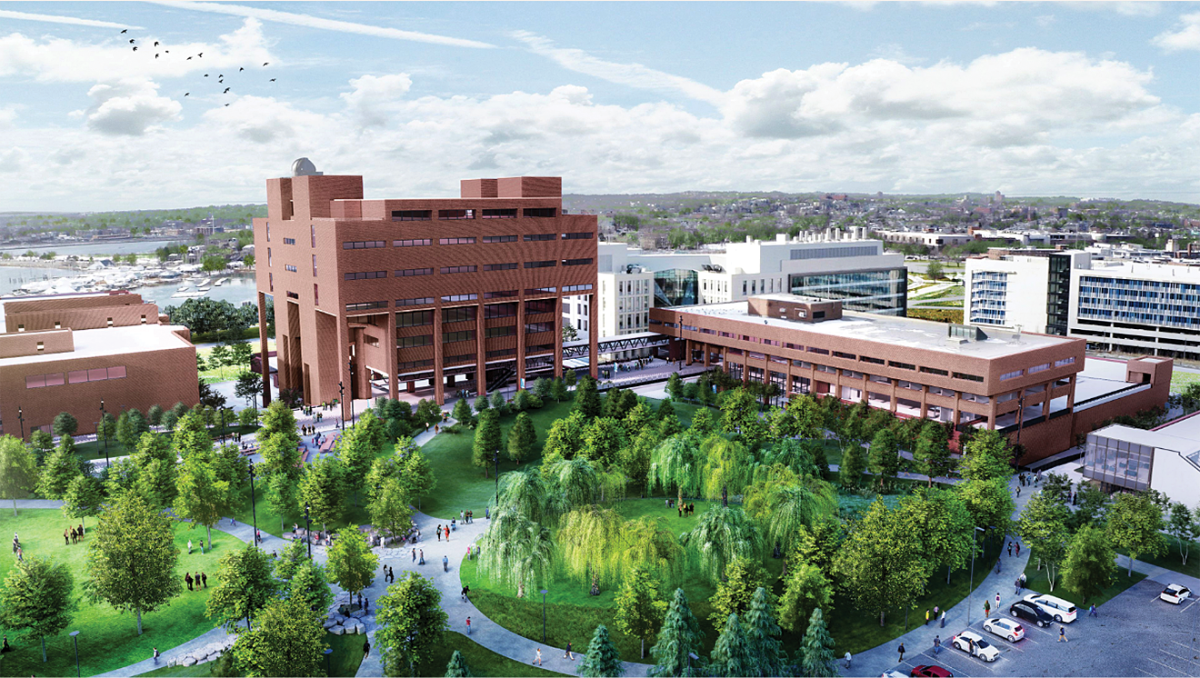April 3, 2024


Marcelo Suárez-Orozco will be officially installed as the ninth permanent chancellor of UMass Boston this Friday (April 5) in a ceremony that will be held, in part, on a newly built campus Quad. Hailed as the new “centerpiece” of the Dorchester Bay campus, the walking paths and green space have replaced what was once the university’s hulking red-brick Science Center and a crumbling parking garage that was long a symbol of dysfunction and decay.
The day-long program of pomp and circumstance comes nearly four years after Suárez-Orozco first arrived in Dorchester. His tenure on the Columbia Point started in lonely fashion at the height of Covid protocols, but even when his fellow humans resurfaced, the 67-year-old Argentina native held off on planning a formal event to mark his official duties.
The completion of the Quad, he says, is the right moment for a “proper celebration.”
“It’s really to use the excuse that I have to be installed to really gather us for a moment of reflection, and for a moment to celebrate and announce a new chapter in the extraordinary history of UMass Boston. I call it, UMass Boston 2.0,” he told the Reporter last week.

The rendering above shows what the fully completed Quad on the UMass Boston campus will look like with mature trees and vegetation. The green space and walking paths have replaced what was a former Science center building and a desolate, concrete plaza that covered a parking garage that had long been closed off because of structural defects that made it unsafe. At right, UMass Boston Chancellor Marcelo Suárez-Orozco greeted visitors in the simulation lab at the Manning College of Nursing and Health Sciences during the announcement of $3 million in funding sponsored by Rep. Lynch earlier this year. Images courtesy UMass Boston
“Our campus is a campus that in some ways, is built on a wound,” says Suárez-Orozco, who keeps a triangle-shaped chunk of concrete close at hand in his office – a piece of the substructure that fell from the now-pulverized underground garage. For years, the garage was an off-limits yet daily reminder of the deficiencies of the system’s Boston footprint.
“We had to finish that. We had to get in front of that. We had to get in front of the wound that was the original building, the drama that was the old garage. We dealt with the issues on some of the buildings that just couldn’t offer us the space our students deserve.”
While Friday’s festivities will train attention on the remarkable improvements to UMass Boston’s physical plant, it’ll also be a full-on butterfly moment for the chancellor, who has been stepping up as a more vocal and visible leader locally of late. Last month, Suárez-Orozco was front-and-center at the roll-out of Mayor Wu’s announcement of a $24 million plan to address what officials say is a crisis in mental health among BPS students. And the chancellor and his administration will play a pivotal role in an emerging plan to re-invent the BCLA-McCormack school, a BPS facility that sits on land adjacent to the UMass Boston campus on Columbia Point. Mayor Wu made the UMass Boston commitment to support BCLA-McCormack— which the School Committee last week voted to re-name in memory of Boston civil rights leader Ruth Batson— a prominent part of her 2024 State of the City speech.
In the interview with the Reporter, Suárez-Orozco spoke expansively about his past experience in a similar partnership with district schools in Los Angeles when he served as the dean of UCLA’s Graduate School of Education and Information Studies.
“I grew a network of university-assisted K12 schools in the most underserved communities in Los Angeles,” he said. “South LA, the historic African American neighborhood in Los Angeles. MacArthur Park. This is all refugees and new arrivals. I was responsible for the Robert F. Kennedy School complex— this was the largest school, when it was built, in the country… I was responsible for how does the university deploy its extraordinary resources to support the work of teachers, to support the parents. We reimagined what a community school is,” he said.
Can Boston expect to see UMass Boston and its chancellor replicate that sort of university-assisted model through the Batson school? In a word: Yes.
Last year, spurred by a conversation with former US Rep. Joe Kennedy III, Suárez-Orozco led a visit to the RFK School that was built on his watch for a “learning tour” that included Boston School Superintendent Mary Skipper and other top aides to Mayor Wu.
“We spent a day in LA visiting the network of schools that I put together. This was an extraordinary initiative. This is a demographic where 20 percent of the kids went to college. Today, over 90 percent of these kids, all kids of color, go to college.”
“We don’t need to reinvent the wheel,” he said. “And furthermore, I made all the mistakes in LA. We don’t have to remake the same mistakes here.”
Chancellor Marcelo Suárez-Orozco with Mayor Wu, left, and Council President Ruthzee Louijeune during a press conference at Dorchester's Lee School on March 21. Seth Daniel photo
Other closely watched initiatives that will ring-out in Suárez-Orozco’s Friday remarks include plans for more space to house UMass Boston’s fast-growing School of Nursing and Health Science. The elimination of the old Science Complex on the core campus has created even more demand for new space to house classes and offices for the program.
Spurred in part by an unprecedented $50 million gift from donors Donna and Robert Manning ($15 million direct to the College of Nursing) and federal funds secured by US Rep. Steve Lynch, the campus is proceeding with a study that will advise Suárez-Orozco and the UMass Building Authority on its next steps.
“Ours is a nationally ranked program. We produce more nurses than any other nursing school in the Commonwealth. It’s not enough. We need to grow the program and to grow the program, we’re going to need to engineer new facilities,” he said. “I’m waiting to get the final report that was commissioned with the support of Congressman Lynch. The current facilities here are wonderful, but we need more space.”
There are site options on the present footprint of the Dorchester campus— and even some thought given to leasing space in the former Globe complex across Morrissey Boulevard, known as the Southline building. One place that is unlikely to house university programs, however, is the massive Dorchester Bay City development that will be built on UMass-owned waterfront land on what was once the Bayside Expo Center. Once it is built out, UMass Boston and the system at large will benefit from the lease agreement that is expected to generate roughly $200 million over the next decade. However, Suárez-Orozco does not anticipate being a tenant there.
“I want something that makes sense,” he said on April 4. “Dorchester Bay City, it’s unlikely that in the current footprint that is being envisioned, we’d get a piece because we would be treated like anybody else, just another tenant. And I’m thinking, I can get a better deal.”
He added: “I want to make clear that I see Dorchester Bay City as an equity endeavor for our campus. Finally, our students are going to have the opportunities that the students on the other side of the river take for granted: internships, scholarships, pathways to work. …And to me, having our students have the same opportunities that are taken for granted elsewhere is fundamentally an equity position.”
Don’t expect to hear any surprise announcements about a fresh round of student dormitories on Columbia Point, either. While the existing 1,100-unit dorms named for his predecessor, Dr. Keith Motley and wife Angela, are “spectacular, with the best views of Boston” in his estimation, there’s “no concrete plans to expand the dormitory space.”
Instead, expect to hear more passionate talk about his campus’s ascendancy and evolving mission in an era of skyrocketing tuitions at other universities in the Boston market.
“We have a noble vision here. And to me, the most important algorithm here is – let’s call it “distance travel.” How far do you get from where you start? That’s it to me. Forget about US News and World Report. Forget about all the fancy rankings.
“What about the kids that show up here now from Haiti? Or from the Dominican Republic. Or from the other islands, from Central America, from Latin America, from Africa, from Asia, with a dream where the families put everything for.”
That’s what brought Marcelo Suárez-Orozco— himself a refugee from an oppressive Latin American dictatorship as a young man —to Dorchester Bay in the first place four years ago.
“I felt this university was – and is – the best kept secret. It began with a crime and with a wound. And it has to be ready. It has to be taken to the next level. “So, I jumped, man. I jumped.”


